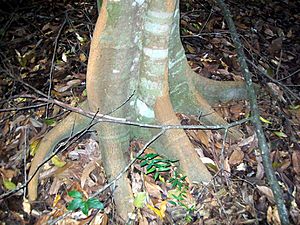Green-leaved rose walnut facts for kids
Quick facts for kids Green-leaved rose walnut |
|
|---|---|
 |
|
| the flanged and buttressed trunk | |
| Scientific classification | |
| Genus: |
Endiandra
|
| Species: |
muelleri
|
The Green-leaved rose walnut (Endiandra muelleri) is a special tree found in the rainforests of eastern Australia. It grows in warm rainforest areas, especially where the soil isn't very rich. You can find this tree from the Allyn River in the Barrington Tops area in the south, all the way up to Kroombit Tops in central Queensland.
People often call it Mueller's walnut or green-leaved rose walnut. Even though it's called a "walnut," it's actually part of the laurel family, not the walnut family. It was named after a famous botanist from the past, Ferdinand von Mueller, who studied many plants.
Types of Green-Leaved Rose Walnut
There are two main types, or subspecies, of Endiandra muelleri. One is called Endiandra muelleri muelleri, and the other is Endiandra muelleri bracteata. The Endiandra muelleri bracteata subspecies is considered an endangered plant, meaning it's very rare and needs protection. You can learn more about the differences between them by looking up Endiandra muelleri bracteata.
What Does the Green-Leaved Rose Walnut Look Like?
The Endiandra muelleri subsp. muelleri tree can grow very tall, up to 30 metres (about 100 feet). Its trunk can be quite wide, reaching about 75 centimetres (30 inches) across. The bottom of the tree's trunk might have special wide, flat parts called buttresses and flanges, which help support it.
The bark of the tree is brown and looks uneven, with dips, hollows, and loose pieces. The small branches that hold the leaves are green and have tiny, flat hairs. When new leaves grow, they are often bright pink or red and have light brown hairs.
The leaves themselves are usually 6 to 12 centimetres (2.4 to 4.7 inches) long and 3 to 5 centimetres (1.2 to 2 inches) wide. They are shiny and smooth on both sides, but a bit lighter green underneath. The leaves are shaped like a wide spear or an oval, and their stems are short, only 3 to 6 millimetres long. Sometimes, on the underside of the leaves of Endiandra muelleri subsp. muelleri, you might see one to four small hairy bumps where the leaf veins meet the main vein.
Flowers, Fruit, and Life Cycle
Small greenish-pink flowers grow in clusters called panicles. These clusters appear from the leaf axils (the spot where a leaf joins the stem) between November and January. For Endiandra muelleri subsp. muelleri, the outer parts of the flowers (called perianth lobes) are hairy.
The fruit of this tree is a dark blue or blackish drupe, which is a type of fruit with a hard pit inside, like a cherry or peach. These fruits are about 15 to 25 millimetres (0.6 to 1 inch) long. They become ripe from March to April.
Many different birds enjoy eating these fruits, including the rose-crowned fruit dove, regent bowerbird, superb fruit-dove, and wompoo fruit-dove. If you want to grow a new tree from a seed, it's a good idea to remove the soft fruit flesh from the seed before planting it. The seeds usually start to sprout after about two months.

